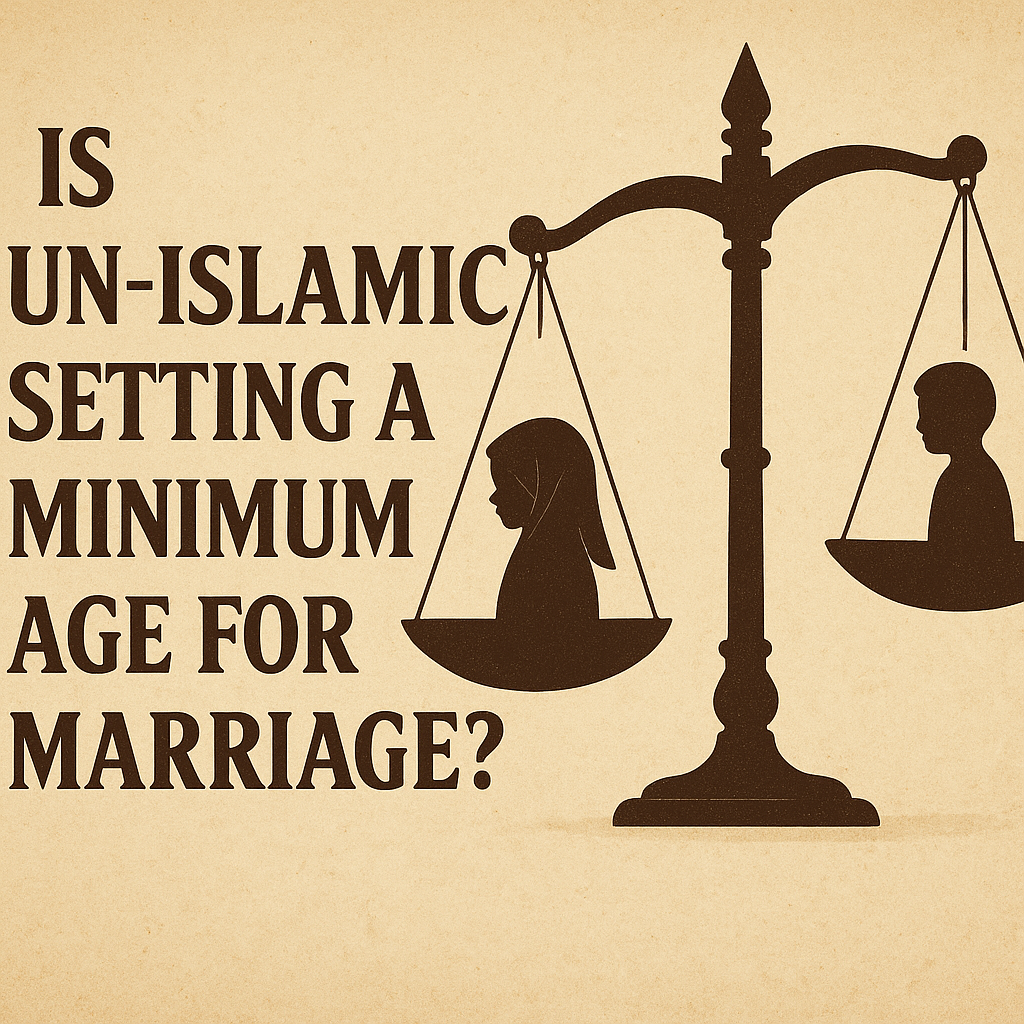Pakistan’s Federal Shariat Court answered a provocative topic in a riveting court ruling: Is it un-Islamic to set a minimum marriage age? Farooq Omar Bhoja contested the Child Marriage Restraint Act, 1929, stating in Shariat Petition No. 10/I of 2020 that Islamic law’s age limitations conflicted with the Act. The court’s decision maintained the law and confirmed the legal system’s congruence with Islamic values as well as Pakistan’s will to shield young girls from early marriages.
Case History
Farooq Omar Bhoja stood at a junction of law and tradition in the energetic metropolis of Karachi. 2020 was here, and the air was fraught with controversy as Bhoja, a resident of Bhoja Terrace on Shahrah-e-Liaqat, boldly petitioned the Federal Shariat Court. With sanctions for individuals who encouraged underage couplings, his focus was on Sections 4, 5, and 6 of the Child Marriage Restraint Act, 1929, which set the minimum marriage age at 16 for girls and 18 for boys. Citing holy books he felt allowed marriages at younger ages, Bhoja’s heart raced as he contended these rules ran counter to Islamic doctrine.
Not new, the Child Marriage Restraint Act was passed under British colonial control to reduce child marriages—a habit well ingrained in some areas of South Asia. But Bhoja’s struggle was as much personal as legal. Drawing on famous Islamic sources, he leaned on a Hadith concerning the marriage of Hazrat Aisha (RA) to the Holy Prophet Muhammad (PBUH), who was six at the time of her betrothal and nine when the marriage was consummated. These writings, to Bhoja, implied that Islamic law let couples choose their marriage age free from legislative restrictions. His petition was more about a general principle—could the state set a minimum age for marriage—than about a particular marriage. Was such a rule un-Islamic?
Karachi, a vibrant city, is not unusual in seeing conflicts between modernism and tradition. Often a battlefield for arguments over faith and law, the city boasts a varied population and rich Islamic legacy. Though it is reducing, child marriage still presents a problem in Pakistan where legal changes may conflict with cultural standards. Bhoja’s story caught on this conflict and highlighted the careful balance between honoring religious customs and shielding young women. Tasked with making sure laws complement Islamic injunctions, the Federal Shariat Court became the scene for this high-stakes drama.
The petition of Farooq Omar Bhoja arrived in the Federal Shariat Court, the highest powerhouse on Islamic law compliance in Pakistan. Advocate Sayyed Tanvir Sohail Shah represented Bhoja, who claimed that age limitations of the Child Marriage Restraint Act went against Islamic values. Based on Ahadith (Prophetic traditions) from famous sources such as Sahih Bukhari, Sahih Muslim, and Sunan an-Nasa’i, he made a strong case. Key to his case was the youthful marriage of Hazrat Aisha (RA) to the Holy Prophet Muhammad (PBUH), which Bhoja asserted established a standard for acceptable early unions. He said the provisions of the Act were un-Islamic since the Quran and Sunnah did not specify a minimum age.
Represented by the Ministry of Law and Justice, the Federation of Pakistan stood behind the Act. They maintained that the law fulfilled a more Islamic role in safeguarding society from harm, a concept also referred to as Sad-uz-Zaraey (stopping the tools of evil). Emphasizing that establishing a minimum age of sixteen for females aligns with Islamic values of protecting health, intelligence, and lineage, the government underlined the physical, emotional, and educational consequences of child marriage. To support the law, they turned to historical instances such as the decisions of Hazrat Umar (RA), who limited some allowed actions for the good of society.
On September 23, 2021, Chief Justice Muhammad Noor Meskanzai and Justices Dr. Syed Muhammad Anwer and Khadim Hussain M. Shaikh presided over the court, hearing arguments. Although Bhoja’s counsel mostly relied on religious literature, the court dug further to ask how these works fit contemporary settings. The government responded with Islamic law, referencing the state’s jurisdiction to control permissible (Mubah) acts for public good as well as the idea of Khiaar-ul-Bulugh, the right of a minor to reject a marriage upon attaining puberty.
The court rendered its decision on October 25, 2021, rejecting Bhoja’s plea in limine—that is, without a complete trial. The court declared the petition misinterpreted and said the clauses of the Child Marriage Restraint Act were not un-Islamic. The ruling not only refutes Bhoja’s assertions but also boldly supports the state’s responsibility in protecting young girls within Islamic law’s limitations.
Ruling and Argument of the Court
With a resounding no, the judicial ruling of the Federal Shariat Court answered the question—Is establishing a minimum age for marriage un-Islamic? Declaring Sections 4, 5, and 6 of the Child Marriage Restraint Act, 1929 compliant with Islamic law, the court maintained the constitutionality of the law under Pakistan’s Constitution and Shariah guidelines.
The court’s thorough approach combined Islamic law with pragmatic concerns:
- Context of Hazrat Aisha’s (RA) Marriage: The court acknowledged the Hadiths on the marriage of Hazrat Aisha (RA) to the Holy Prophet Muhammad (PBUH), but it clarified its particular setting. Linked to her position as an Ummul-Momineen (Mother of the Believers), her marriage was a divine mandate. Such extraordinary circumstances, the court decided, do not establish a general standard for common Muslims.
- Right of Rejection at Puberty: The court underlined the Islamic concept of Khiaar-ul-Bulugh, which lets a girl wedded as a juvenile reject the marriage upon puberty. Establishing the minimum age at sixteen corresponds with this right, thus enabling females to make wise decisions before consummation, reducing their danger of forced marriages.
- Principle of Avoiding Harm (Sad-uz-Zaraey): The justices observed that child marriages harm girls’ mental development, education, and general health. The Act’s age restrictions are supported by the state’s capacity to control permitted conduct, as demonstrated by Hazrat Umar’s (RA) prohibitions on triple talaq and mixed marriages.
- Variability in Medical Maturity: The court acknowledged that elements including food, environment, and socioeconomic level affect medical maturity. Setting 16 as the minimum age helps the legislation decrease the risk of marriages before physical and mental readiness, thus complementing Islamic objectives of preserving life and intellect.
- Education and Empowerment: The court connected the minimum age to the emphasis on education, a mandatory obligation for all Muslims, taught by the Holy Prophet Muhammad (PBUH). Delaying marriage guarantees girls can pursue basic education, thus promoting intellectual development and empowerment—two fundamental principles of Maqasid-us-Shariah (Shariah goals).
- Juristic Diversity: Although most Muslim jurists allow small marriages, some, like Imam Ibn-e-Shabarma, object to them. The court acknowledged this diversity and concluded that while different points of view exist, the limitations of the Act do not breach a unanimous Islamic consensus.
Maqasid-us-Shariah, which gives preservation of religion, life, knowledge, lineage, and property top priority, guided the court’s interpretation. Under Islamic law, the Act is not only permitted but also required by preventing the negative effects of early marriage, thus preserving these objectives.
Lessons and Final Thought
Is defining a minimum age for marriage un-Islamic? Stressing at the core of faith, law, and society is this question. The court ruling of the Federal Shariat Court has great lessons for Pakistan’s legal system, legislators, and people:
- Balance Between Tradition and Progress: The verdict demonstrates how Islamic law, under the guidance of the Holy Prophet Muhammad (PBUH), can adapt to new needs without losing its core. The court ensured girls’ rights by maintaining the Child Marriage Restraint Act, bridging religious values with modern issues.
- State’s Role in Public Welfare: As Hazrat Umar (RA) shows, the ruling supports the state’s ability to control allowed acts for societal benefit. Modern laws, a paradigm for further legal system reforms, can impose limits to stop abuse.
- Education as a Right: The court’s emphasis on education, a responsibility stressed by the Holy Prophet Muhammad (PBUH), highlights its role in empowering girls. Delaying marriage until 16 ensures access to education, in line with Islam’s obligation to seek knowledge—a lesson for governments and legislators.
The decision tells authorities and families that child marriage is a harm the legal system must address, not merely a cultural norm. Age restrictions must be enforced by courts and police in order to honor the protective spirit of Islamic law and guard young girls.
This scenario offers a ray of hope for the typical readers. It shows how deftly Pakistan’s court system can address difficult problems, preserving Islamic values as taught by the Holy Prophet Muhammad (PBUH) and improving human rights. The issue of minimum age for marriage is important since it influences millions of girls, their futures, and the development of the country. Early marriage often locks girls into cycles of poverty and ignorance, but this decision opens the path for change.
The meaning of this court ruling is found in its knock-on effects. It forces societies to reconsider child marriage, calls legislators to increase enforcement, and lets girls dream beyond early marriage. For other Islamic nations—where such laws exist in Jordan, Malaysia, and Tunisia—it also establishes a precedent showing that faith and reform may coexist under the guidance of Islamic values.
Though denied, Farooq Omar Bhoja’s appeal started an important dialogue. Through his challenge, the court was compelled to define Islam’s position on child marriage, dispelling misconceptions and validating the law. Rooted in the Quran and the Sunnah of the Holy Prophet Muhammad (PBUH), the question—Is imposing a minimum age for marriage un-Islamic—has a clear answer: No, it’s a step toward fairness.
This case is a tale of bravery and clarity, not only a legal turning point. It reminds us that the legal system can defend the vulnerable and respect faith if it is directed by the wisdom of Islamic doctrines. This decision whispers a promise to every girl in Pakistan: Your future is yours to determine, as envisioned by the values laid down by the Holy Prophet Muhammad (PBUH) and upheld by honorable leaders like Hazrat Umar (RA) and Hazrat Aisha (RA).
Note: Discreet
Though it may include mistakes, this blog is a translation or overview of the original court ruling. Regarding any legal reference, kindly review the original decision.
https://www.federalshariatcourt.gov.pk/Judgments/Sr.P.No.10.I.of.2020.pdf




